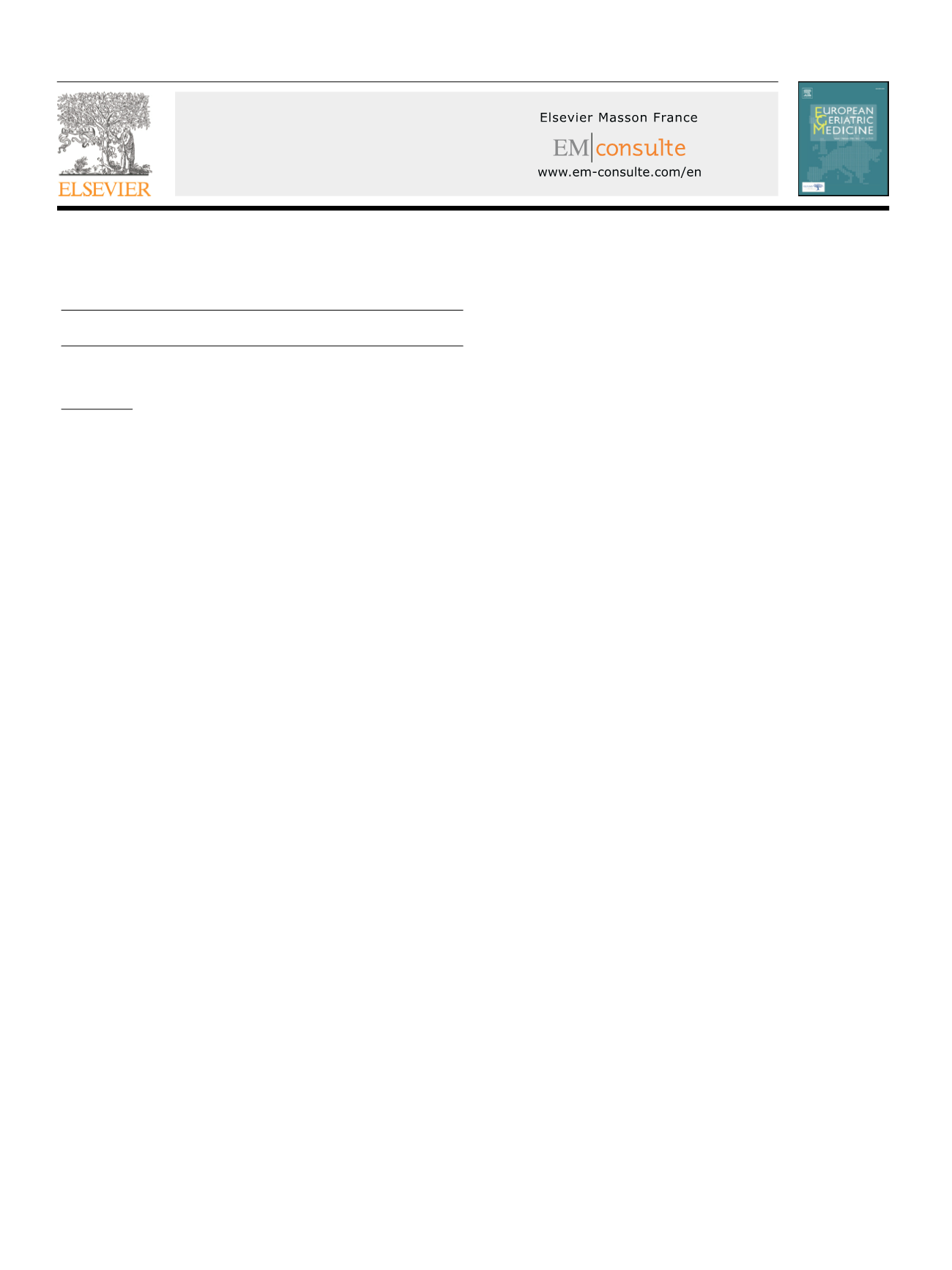

European Geriatric Medicine 6S1 (2015) S157–S176
Available
online
at
ScienceDirect
www.sciencedirect.comSymposia
Invited symposium
S-02
The old kidney
–
challenges and possibilities
R. Pettersen
Lovisenberg Diacon Hospital, Oslo, Norway
Chair:
Renate Pettersen, MD PhD, Geriatric Department,
Lovisenberg Diacon Hospital, Oslo, Norway
As a consequence of the increasing lifespan in Europe and other
parts of the world, clinicians will face an increasing prevalence
of renal dysfunction in the older population – due to both
physiological changes and disease. The processes involved are
complex and represent a challenge for the clinician. The increasing
prevalence of end-stage kidney disease in this age group also raises
questions about choice of treatment. In this symposium, important
basic mechanisms and new aspects of the assessment of renal
function will be presented, as well as new data on transplantation
outcomes.
Water and electrolyte physiology in old age
–
clinical and
experimental data
(Professor Elias Lianos, Athens, Greece): The
homeostatic control of water and electrolyte balance by the aging
kidney is impaired, the key reason being that the physiologic limits
for the excretion of water, sodium, potassium, and hydrogen ions are
narrowed. As aging progresses, the risk of hyper- or hypovolemia
increases owing to impaired water handling. Control of potassium
level also becomes impaired resulting in hyperkalemia, particularly
when patients receive certain drugs. Specific changes in water
and electrolyte homeostasis include: decrease in total body
water, urinary concentrating ability, aldosterone secretion/effect,
thirst mechanism and free-water clearance, and an increase
in antidiuretic hormone (ADH). Despite these changes, body
fluid homeostasis is effectively maintained under normal day-to-
day circumstances. Problems are frequently iatrogenic and arise
when older patients are placed under fluid restriction or are
prescribed medications that further derail the already impaired
homeostatic control of water and electrolytes. Awareness of age-
related limitations of fluid and electrolyte homeostasis can help
the physician prevent complications such as hypotonicity and
hypertonicity, hyperkalemia, and volume depletion.
Differences between decreased GFR and renal failure: clinical,
social and economic consequences from the geriatric angle
(Professor Juan F. Macias Nunez, Salamanca, Spain): Chronic renal
insufficiency (CRI) is identified by a decrease in GFR. It is a clinical
daily practice to diagnose CRI based on the critical value of eGFR
<
60ml/min by means of the MDRD screening formula, not validated
for persons aged
>
70 years. We should always remember the
difference between screening formulae and diagnosis. Diagnose
of CRI should be confirmed by doctors in persons suspicious of CRI
by screening formulae.
The normal ageing process is characterized by a decrease in
GFR without repercussion in the equilibrium of the internal
milieu. GFR reaches a peak between 120–130ml/min/1.73m
2
at
the age of 30, attenuating at a constant rate of 0.8ml/min/year,
although for persons aged 70–110 years, the decline averages
1.05ml/min/year. Establishing an incorrect diagnosis of CRI will
have some undesirable effects. The worst is that may deny aged
individuals appropriate treatment for other diseases (oncological,
haematological or others) and also prevent from being included
in clinical trials because the tendency to equalize CRI to
eGFR
<
60ml/min. To overcome this error, we found that the
association of haematocrit, urea and gender (HUGE) according to
the following formula:
L = 2.505458 − 0.264418
·
Hematocrit + 0.118100
·
Urea [+ 1.383960 if
male],
showed the highest ability to discriminate CRI from non CRI
individuals. The HUGE formula, with data obtained from a
general population, offers a straightforward readily available
and inexpensive tool to differentiate CRI from eGFR
<
60ml/min
particularly useful in persons
>
70 years.
Kidney transplantation
–
a treatment option for the failing old
kidney?
(Associate Professor Kristian Heldal, Skien, Norway): The
general population is getting older. The dramatic increase of
patients developing end-stage renal disease (ESRD) has occurred
predominantly in the older adult population. In old patients with
ESRD the nephrologists will need to decide further treatment. The
options are; medical treatment only, life-long dialysis or kidney
transplantation (KTx). There are very few absolute contraindications
(active infection, recent malignancy), but many relative or potential
contraindications in older patients considered for KTx. Worldwide,
organs available for transplantation are limited. Many transplant
centers therefore set an upper age limit for KTx. In Norway there
is no upper age limit. Even octogenarians may be transplanted. It
is vital that patients who are accepted for KTx are those who will
derive most benefit, and correct selection of patients is therefore
of outmost importance.
Currently older patients are evaluated for transplantation using the
same algorithm as used for younger patients. Survival analyses have
revealed that even patients older than 70 years of age will benefit
from transplantation compared with permanent dialysis with the
proviso that the patient is capable of tolerating surgery and the
subsequent medical treatment (i.e. burden of immunosuppression).
Prolonged time on dialysis treatment and presence of acute allograft
rejection, have been identified as modifiable risk factors for poor
survival. To shorten the time on dialysis before transplantation,
it is important to increase the number of available donor organs.
This can be done by use of living donors or older deceased donors
for older patients. By optimizing the immunosuppressive therapy
number of acute rejections can be reduced. The post operative cost
of a successful KTx is approximately 8000 €/year while continued
dialysis costs 7–80,000 €/year. KTx is thus an attractive treatment
option for eligible patients both in terms of survival and economics
Even if transplantation increases survival, information about older
patients’ health related quality of life (HRQOL) after transplantation
is lacking. At present we are conducting a study comprising
approximately 200 kidney transplant candidates with the aim of
describing HRQOL longitudinally from time of wait listing until five
1878-7649//$ – see front matter © 2015 Elsevier Masson SAS and European Union Geriatric Medicine Society. All rights reserved.



















